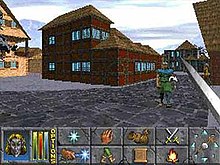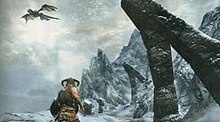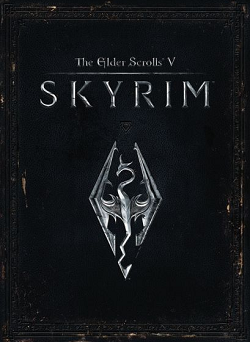Arena (1992–1994)
Prior to working on the Elder Scrolls series, Bethesda had worked predominantly with sports games. In the six years from their founding to Arena’s release, in 1992, Bethesda had released ten games, six of them sports games[1]—games with such titles as Hockey League Simulator, NCAA Basketball: Road To The Final Four (’91/’92 Edition), and Wayne Gretzky Hockey[2]—and the remaining four adaptations from other media[1]—adaptations predominantly from the Terminator series.[2] Bethesda’s history as a sport and port game developer did not help it when it began its first action-RPG venture. Designer Ted Peterson recalls the experience: “I remember talking to the guys at SirTech who were doing Wizardry: Crusaders of the Dark Savant at the time, and them literally laughing at us for thinking we could do it.”[3] Ted Peterson worked alongside Vijay Lakshman as one of the two designers of what was then simply Arena, a “medieval-style gladiator game.”[3][4]
Peterson and Lakshman were joined by Julian LeFay in, according to Peterson, “really spear-headed the initial development of the series.”[3] Peterson, Lakshman and LeFay were longtime aficionados of pencil and paper role-playing games,[3] and it was from these games that the world of Tamriel was created.[4] They were also fans of Looking Glass Studios’ Ultima Underworld series, which became their main inspiration for Arena.[3] Initially, Arena was not to be an RPG at all. The player, and a team of his fighters, would travel about a world fighting other teams in their arenas until the player became “grand champion” in the world’s capital, the Imperial City.[4] Along the way, side quests of a more role-playing nature could be completed. As the process of development progressed, however, the tournaments became less important and the side quests more.[3] RPG elements were added to the game, as the game expanded to include the cities outside the arenas, and dungeons beyond the cities.[4] Eventually it was decided to drop the idea of tournaments altogether, and focus on quests and dungeons,[3] making the game a “full-blown RPG”.[4] Although the team had dropped all arena combat from the end game, because all the material had already been printed up with the title, the game went to market as The Elder Scrolls: Arena. Lakshman who came up with the idea of “The Elder Scrolls”,[3] and the words eventually came to mean “Tamriel’s mystical tomes of knowledge that told of its past, present, and future.”[4] The game’s initial voice-over was changed in response, beginning: “It has been foretold in the Elder Scrolls …”[3]
Bethesda missed their Christmas 1993 deadline, and released the game in the first quarter of 1994, “really serious for a small developer/publisher like Bethesda Softworks.” The packaging included a scantily clad female warrior which further contributed to distributor distaste for the game, leading to an initial distribution of only 10,000 units. “We were sure we had screwed the company and we’d go out of business.” Nonetheless, sales continued to grow, month after month, as news of the game was passed on by word-of-mouth.[3] Despite harsh reviews, general bugginess,[3] and the formidable demands the game made on players’ machines,[5] the game became a cult hit.[1] Evaluations of the game’s success vary from “minor”[3] to “modest”[5] to “wild”.[1] Game historian Matt Barton concludes that, in any case, “the game set a new standard for this type of CRPG, and demonstrated just how much room was left for innovation.”[5]
Daggerfall, Battlespire and Redguard (1994–1998)
Work on The Elder Scrolls II: Daggerfall began immediately after Arena’s release in March 1994.[6] Ted Peterson was assigned the role of Lead Game Designer.[3] Daggerfall’s plot was less clichéd than Arena’s and involved a “complex series of adventures leading to multiple resolutions”.[3] With Daggerfall, Arena’s experience-point based system was replaced with one that rewarded the player for actually role-playing their character.[6] Daggerfall came equipped with an improved character generation engine, one that included a GURPS-influenced class creation system, offering players the chance to create their own classes, and assign their own skills.[3][7] Daggerfall was developed with an XnGine engine, one of the first truly 3D engines. Daggerfall realized a gameworld twice the size of Great Britain,[6] filled with 15,000 towns and a population of 750,000.[1] It was influenced by analog games and literature Julian LeFay or Ted Peterson happened to be playing or reading at the time, such as Dumas’s The Man in the Iron Mask and Vampire: The Masquerade.[3] It was released on August 31, 1996.[8] Like Arena, Daggerfall’s release suffered from buggy code, leaving consumers disgruntled.[5] This led to a more cautious release schedule for future games.[9]
Following the release of Daggerfall, work began on three separate projects all at once: Battlespire, Redguard, and Morrowind. Battlespire, originally titled Dungeon of Daggerfall: Battlespire, was the first of the three to be released,[10] on November 30, 1997.[11] Originally designed as an expansion pack for Daggerfall, it was repackaged as a stand-alone game. Battlespire focused on dungeon romping and offered multiplayer gaming—player versus player deathmatch— the only series title to do so as of 2011.[10] Redguard was the second of the three titles to be released, on October 31, 1998.[12] It was a pure action-adventure game inspired by Tomb Raider, Prince of Persia, and the Ultima series.[13] Redguard did not offer the player the chance to create their own character. Instead, players would play the prefabricated “Cyrus the Redguard”.[13] Both games were failures with the gaming public. Players used to the vast open spaces of Daggerfall did not take well to the reduced worlds of Redguard and Battlespire. There was a downturn in sales in The Elder Scrolls franchise and Bethesda redoubled its efforts to build the next major chapter.[1]

A first-person screenshot from Daggerfall, demonstrating the user interface and graphical capabilities of the game.
Morrowind (1998–2003)
The third title in the Elder Scrolls series was first conceived during the development of Daggerfall.[14] Initially designed to encompassing the whole province of Morrowind and allow the player to join all five Dunmer Great Houses it was decided that the scope was too grand given the technology current at the time.[14] At publication it covered just the isle of Vvardenfell and allowed the player to only join three of the Great Houses. The XnGine was scrapped and replaced with Numerical Design Limited’s Gamebryo, a Direct3D powered engine, with T&L capacity,[15]> 32-bit textures and skeletal animation.[16] It was decided that the game world would be populated using the methods the team had developed in Redguard; with the game objects crafted by hand, rather than generated using the random algorithmic methods.[17]
The project took “close to 100 man-years to create”. Bethesda tripled their staff and spent the first year developing the The Elder Scrolls Construction Set. This allowed the game staff to easily balance the game and to modify it in small increments rather than large.[14] Ted Peterson, who had left following the release of Daggerfall, returned to work as an author of in-game material, and as a general consultant on the lore-based aspects of the work.[18] The PC version of Morrowind had gone gold by April 23, 2002,[19] and was released on May 1 in North America,[20] with the Xbox release set at June 7.[21] On January 3, Bethesda announced that game publisher Ubisoft would take control of Morrowind’s European distribution, in addition to those of eight other Bethesda games.[22]
The Elder Scrolls III: Tribunal expansion pack went gold on November 1[23] and was released, with little fanfare,[24] on November 6.[25] Tribunal puts the player in the self-contained, walled city of Mournhold, which can be teleported to from Morrowind’s land mass.[23] Development on the game began immediately after Morrowind shipped, giving the developers a mere five-month development cycle to release the game. The prior existence of the Construction Set, however, meant that the team “already had the tools in place to add content and features very quickly”.[26] Interface improvements, and specifically an overhaul of Morrowind’s journal system, were among the key goals.[26][27]Morrowind ‘s second expansion, The Elder Scrolls III: Bloodmoon, went gold by May 23,[28] and was released on June 6.[29] It had been worked on since the release of Tribunal.[30] In the expansion the player travels to the frozen island of Solstheim and is asked to investigate the uneasiness of the soldiers stationed there.

A third-person screenshot from the game, demonstrating Morrowind’s then-advanced graphics: Pixel-shaded water, “long” render distances, and detailed textures and models.
Oblivion and Skyrim (2006–2011)
Work on The Elder Scrolls IV: Oblivion began in 2002, immediately after Morrowind’s publication.[31] Oblivion was developed by Bethesda Softworks, and the initial Xbox 360 and Personal computer (PC) releases were co-published by Bethesda and Take-Two Interactive subsidiary 2K Games.[32] Oblivion was released in March 21, 2006.[33] Developers working on Oblivion focused on providing a tighter storyline, more developed characters[34][35] and to make information in the game world more accessible to players.[36] Oblivion features improved AI,[37][38] improved physics,[dead link][39][dead link][40] and improved graphics.[39][41][42] Bethesda developed and implemented procedural content creation tools in the creation of Oblivion’s terrain, leading to landscapes that are more complex and realistic than those of past titles, but had less of a drain on Bethesda’s staff.[43][44]
In August 2010, Todd Howard revealed Bethesda were currently working on a game that had been in development since the release of Oblivion, and that progress was very far along. While the game was conceptualized after Oblivion’s release, main development was restricted until after Fallout 3 was released.[45] In November, a journalist from Eurogamer Denmark reported overhearing a developer on a plane talking about the project; a new The Elder Scrolls game,[46][47] although Bethesda did not comment on the report. At the Spike Video Game Awards in December, Todd Howard appeared on stage to unveil a teaser trailer and announce the title of the game.[48] The Elder Scrolls V: Skyrim was released on November 11, 2011.
On May 3, 2012, The Elder Scrolls Online was revealed, which will be released for Windows, Mac, Xbox One and PS4 in 2014.

A third-person screenshot from Skyrim.




























